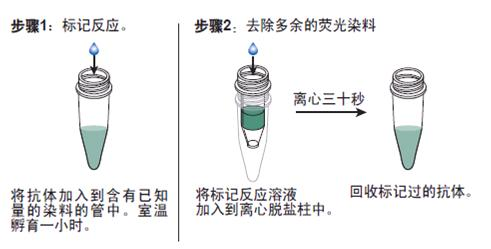 歡迎來到hth体育网址網站!
歡迎來到hth体育网址網站! 谘詢電話:18321818584
谘詢電話:18321818584 歡迎來到hth体育网址網站!
歡迎來到hth体育网址網站! 谘詢電話:18321818584
谘詢電話:18321818584產(chan) 品分類
Product Category相關(guan) 文章
Related Articles詳細介紹
商品屬性:
貨號 | 產(chan) 品名稱 | 規格 |
GOY-01K5399 | G蛋白偶聯受體(ti) 169抗體(ti) | 50ul |
GOY-01K5399 | G蛋白偶聯受體(ti) 169抗體(ti) | 100ul |
GOY-01K5399 | G蛋白偶聯受體(ti) 169抗體(ti) | 200ul |
英文名稱: MRGPRG
中文名稱: G蛋白偶聯受體(ti) 169抗體(ti)
英文別名 G protein coupled receptor 169; G protein
coupled receptor MRGG; G-protein coupled receptor 169; GPR169; Mas related G
protein coupled receptor member G; MAS related GPR member G; Mas-related
G-protein coupled receptor member G; MRGG; MRGPRG; MRGRG_HUMAN.
交叉反應 Human
標記
Unconjugated
抗體(ti) 來源 Rabbit
抗體(ti) 類型 Polyclonal
免疫原
KLH conjugated synthetic peptide derived from human MRGPRG
蛋白細胞定位 細胞膜
純化方法 affinity purified by Protein A
亞(ya) 型
IgG
性狀
Liquid
濃度
1mg/ml
儲(chu) 存液
0.01M TBS(pH7.4) with 1% BSA, 0.03% Proclin300 and 50% Glycerol.
保存條件 Shipped at 4℃. Store at -20 °C for one year. Avoid repeated freeze/thaw cycles.
產(chan) 品介紹 MRGG is a 289 amino acid multi-pass membrane protein that functions as an orphan receptor. A member of the G-protein coupled receptor 1 family and Mas subfamily, MRGG is implicated in pain sensation and modulation by regulating nociceptor function. The gene encoding MRGG maps to human chromosome 11, which comprises approximately 4% of human genomic DNA and is considered a gene and disease association dense chromosome. The chromosome 11 encoded Atm gene is important for regulation of cell cycle arrest and apoptosis following double strand DNA breaks. Atm mutation leads to the disorder known as ataxia-telangiectasia. The blood disorders Sickle cell anemia and thalassemia are caused by HBB gene mutations, while Wilms' tumors, WAGR syndrome and Denys-Drash syndrome are associated with mutations of the WT1 gene. Jervell and Lange-Nielsen syndrome, Jacobsen syndrome, Niemann-Pick disease, hereditary angioedema and Smith-Lemli-Opitz syndrome are also associated with defects in chromosome 11-encoded genes.

實驗流程:

(1)特異性結合抗原:抗體(ti) 本身不能直接溶解或殺傷(shang) 帶有特異抗原的靶細胞,通常需要補體(ti) 或吞噬細胞等共同發揮效應以清除病原微生物或導致病理損傷(shang) 。然而,抗體(ti) 可通過與(yu) 病毒或毒素的特異性結合,直接發揮中和病毒的作用。
(2)活補體(ti) :IgM、IgG1、IgG2和IgG3可通過經典途徑激活補體(ti) ,凝聚的IgA、IgG4和IgE可通過替代途徑激活補體(ti) 。
(3)結合細胞:不同類別的免疫球蛋白,可結合不同種的細胞,參與(yu) 免疫應答。
(4)可通過胎盤及粘膜:免疫球蛋白G(IgG)能通過胎盤進入胎兒(er) 血流中,使胎兒(er) 形成自然被動
免疫。免疫球蛋白A(IgA)可通過消化道及呼吸道粘膜,是粘膜局部抗感染免疫的主要因素。
(5)具有抗原性:抗體(ti) 分子是一種蛋白質,也具有刺機體(ti) 產(chan) 生免疫應答的性能。不同的免疫球蛋白分子,各具有不同的抗原性。
(6)抗體(ti) 對理化因子的抵抗力與(yu) 一般球蛋白相同:不耐熱,60~70℃即被破壞。各種酶及能使蛋白質凝固變性的物質,均能破壞抗體(ti) 的作用。抗體(ti) 可被中性鹽類沉澱。在生產(chan) 上常可用硫酸銨或硫酸鈉從(cong) 免疫血清中沉澱出含有抗體(ti) 的球蛋白,再經透析法將其純化。
抗體(ti) 的製備過程:
1.免疫原:普通的大分子蛋白,通過分子克隆構建載體(ti) 並在大腸杆菌中進行誘導表達獲得重組蛋白,純化鑒定後可直接作為(wei) 免疫原;小分子蛋白或化合物等分子量小,需要偶聯載體(ti) 對該分子進行改造才能使其成為(wei) 具有免疫原性的抗原,常見偶聯載體(ti) 如BSA、OVA、HAS等。
2. 免疫動物:常用於(yu) 製備抗血清的動物有豚鼠、家兔、雞、大小鼠等,大量生產(chan) 時需要用到狗、綿羊、山羊等。

3.免疫血清的收集:一般家兔、綿羊、山羊可采用靜動脈采血,家兔、豚鼠、大鼠、雞可采用心髒采血,家兔、山羊、綿羊可采用靜脈采血。
4. 免疫血清的純化與(yu) 鑒定:得到的抗血清需要進一步的純化,利用偶聯了抗原的親(qin) 和柱進行層析,具有高效,特異性強,純度高的特定。接著要鑒定純化蛋白的含量、相對分子的質量、純度以及特異性。
5.G蛋白偶聯受體(ti) 169抗體(ti) 免疫血清的保存:抗體(ti) 一般比較穩定,在-80℃ ~-20 ℃可以保存約5年而不會(hui) 影響效價(jia) ,而真空幹燥保存時間可以更久。保存前需經除菌並添加防腐劑。
產(chan) 品谘詢
電話
微信掃一掃
